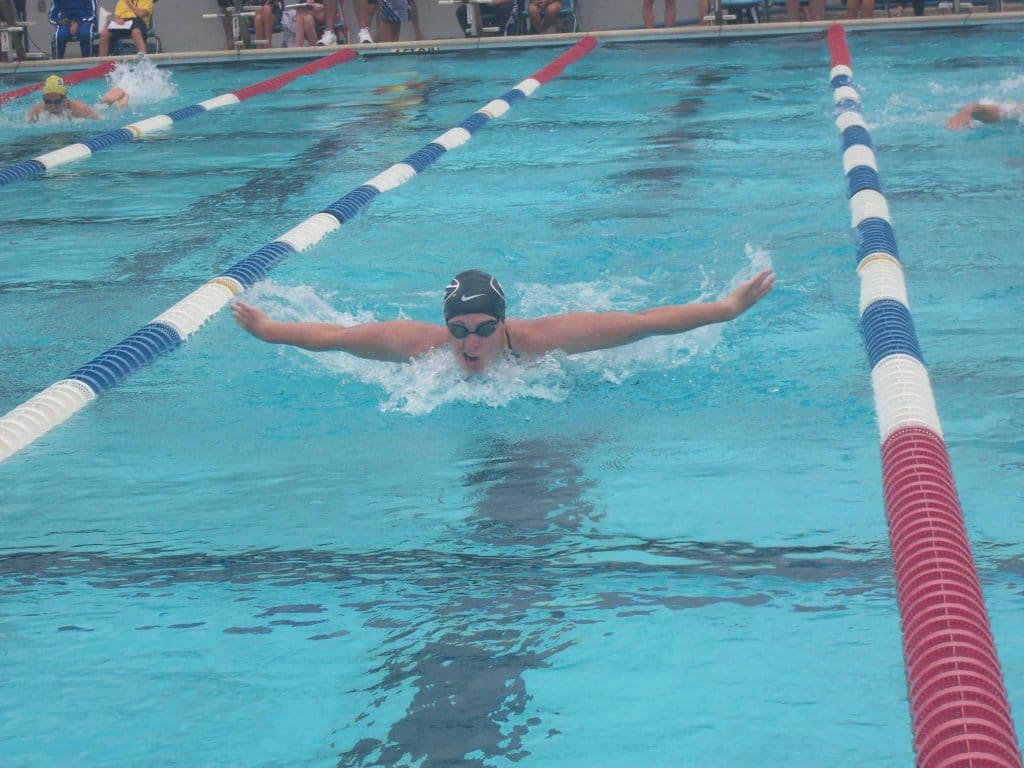Since the start of the New Year, I’ve been away from home traveling. In a month coined “Abbie’s Insanity January” by the SLAF team, I’ve been on planes, trains, cars, snow skis, and more – all so that I could host technique talks, help with swim camps, and spread my swim technique love from coast to coast of the United States. Throughout my time on the road, I’ve gotten one question over and over again… “What is the most common mistake you see with X stroke? I’ve heard this question so many times that I thought it needed to be answered, stroke by stroke, in blog form. So welcome to “Common Butterfly Mistakes You Might Be Making”. It’s sure to be a good one.
Let’s Get Started
So first I think it’s important that we define what a mistake is in my eyes as a swim technique professional:
A mistake is something that COSTS YOU TIME. It’s a missed opportunity that can be found in your swim technique. And fixing the mistake makes you FASTER. That’s why it’s very much worth it for you to know what the common Butterfly mistakes are, so that you can hone in on whether or not your Butterfly is losing time with every stroke you take.
Common Butterfly Mistake #1: Missing the 2nd Kick
Missing the 2nd kick is such an important concept that I actually wrote an entire blog on it already. Butterfly is an incredibly leg driven stroke. The problem is that a lot of swimmers try to drive their propulsion from their arms. But the reality is, doing that won’t work.
The legs DRIVE the timing of a swimmer’s Butterfly. The proper order should be KICK–HANDS ENTER-KICK–HANDS PULL THROUGH. It’s all up to the second kick to really drive through the finish of the stroke and to allow for a smooth recovery at the top. And a lot of it is happening simultaneously. Check out an Instagram video I recently posted where we talk about the Dolphin Kick:
If you miss the second kick, there is no propulsion from the entire time your hands pull through all the way to the time that they enter the water again for your next stroke. So not only does the second kick keep the beat, but it CREATES propulsion when nothing is happening from your arms on the recovery.
And yet, despite all of these benefits, the Most Common Butterfly Mistake I see is swimmers not emphasizing this kick. Some swimmers ignore the second kick completely in an effort to save energy (spoiler alert: it actually costs you more energy to swim without the second kick because you mess up your timing).
Common Butterfly Mistake #2: Ignoring Proper Arm Recovery
Proper arm recovery is actually a broad mistake that people make. Because everyone’s stroke is so different, the recovery mistake can look very different from swimmer to swimmer. But when a swimmer gets their recovery correct, there’s no mistaking that perfect butterfly arm position and easy recovery.
Your arm recovery should be even across the water and should be over the water. You’d be surprised at how many swimmers swear it feels like they’re recovering over the water, but in fact are only getting their elbows up and over the water. Arms should hit the water at the same time, and recover out on the other side together. Like this:

and evenly distributed on both sides.
Apart from the SHAPE that your Butterfly arms should be, another common butterfly mistake I see with the arm recovery is throwing your arms DOWN to start the stroke, rather than flying them FORWARD. I actually wrote a Blog Post called “Don’t Dive Down – Fly Forward” that focuses more on this topic. The good news is that if you’re using your legs to drive your Butterfly, this likely won’t be your problem. That’s because the legs are driving you forward and your arms are just along for the ride. But the reality is that a lot of swimmers try to use their arms to drive propulsion, and that’s where you get into situations where swimmers are throwing their arms down.
Remember – you’re trying to get from one wall to another as fast as possible, so always be moving that direction! Throwing your arms down is quite literally the wrong direction.
Common Butterfly Mistake #3: Forgetting to Finish Your Pull
Finally, the last most common butterfly mistake that I see is when a swimmer does not finish their pull. This one kills me! As someone who is obsessed with making swimmers FASTER, this is such an easy fix. And, it’s a fix that will set you apart from your competitors.
The most common place that a swimmer will finish their pull is at their hips. But that’s actually losing out on all of the momentum you just generated. A good rule of thumb is to make sure that a swimmer is full extending their arms (your triceps will be doing most of the work here) BEFORE letting them exit the water. You should always lead with the elbow on exit, but the arms should be at about a 170-degrees of extension.

Similar to mistake #1, not pulling all the way through is going to feel like you are expending more energy with each stroke. But in reality, getting the most from your pull will help you generate more momentum, take less strokes per lap, and overall expend less energy because you’re going faster.
For more specific mistakes on every part of the Butterfly Pull, check out: Part IV: Butterfly Pull – Don’t sweep out, pull back!
So there you have it… the 3 most common butterfly mistakes I see on a day to day basis! Make sure to be honest with yourself when you’re reflecting on if some of these mistakes are impacting you.
Until Next Time,
Abbie Fish and the SLAF Team

One Response